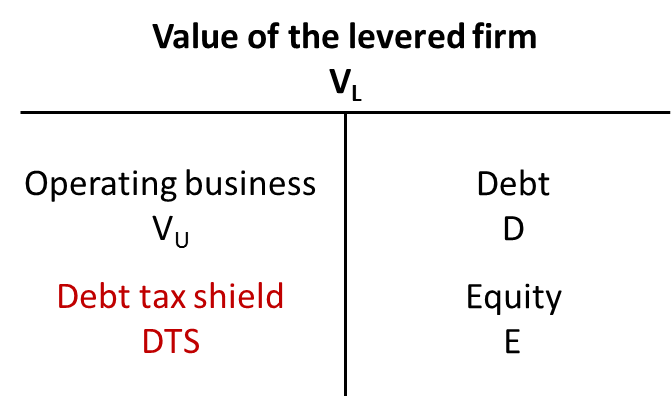Reading: The Relevance of Taxes
3. The Cost of Capital
To understand the implications of taxes on the cost of capital, let us start with the firm's balance sheet at market values from before:

In the previous section we have established that the expected total return generated by the left side of the balance sheet (VU and DTS) must correspond to the expected total return that the debt and equityholders claim (D and E).
We have also established:
- The firm's operating business is expected to generate a return that corresponds to the costs of assets, kA.
- The debtholders expect to earn a return that corresponds to the cost of debt, kD.
- The shareholders expect to earn a return that corresponds to the cost of equity, kE.
But what about the debt tax shield (DTS)? What's the appropriate discount rate for the firm's future interest tax savings? To find an answer, it makes sense to think a bit about the firm's financing policy. Very generally speaking, firms can pursue two types of financing policies (or a mixture thereof):
- Target debt ratio: Borrow a more or less constant % of firm value (say, for example, debt is 40% of firm value).The implication of such a policy are:
- To remain at the target debt ratio, firms borrow more if firm value increases and they borrow less if firm value goes down.
- The amount of debt outstanding fluctuates with the value of the firm's operating business.
- Therefore, also the interest tax savings fluctuate with the value of the operating business.
- Consequently, the riskiness of the debt tax shield (DTS) is similar to the riskiness of the firm's operating activities.
- If a firm pursues a target debt ratio (in % of firm value), it therefore makes sense to use the overall cost of capital (kA) as the discount rate for the future interest tax savings.
- Target debt levels: Alternatively, firms could borrow a specific amount of debt (say, 10 million) and do not «constantly» adjust debt outstanding if the value of the business fluctuates. The implications of such a policy are:
- Debt outstanding is less directly related to the fluctuations of business operations
- Whether or not the firm can pay interest (and benefit from the associated tax savings) is more or less driven by its credit risk.
- This credit risk is approximately summarized by the firm's cost of debt kD.
- If a firm pursues target debt levels (in currency), it therefore makes sense to use the cost of debt (kD) as the discount rate for the future interest tax savings.
- Use the overall cost of assets, kA, if the firm pursues a target debt ratio (in %)
- Use the cost of debt, kD, if the firm pursues target debt levels (in currency).
In what follows, we look at the implications of these considerations for the firm's cost of capital.